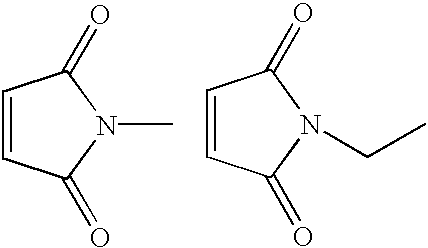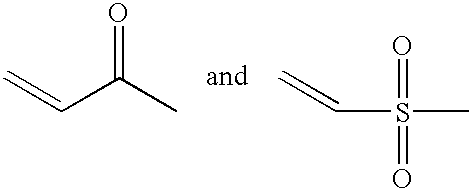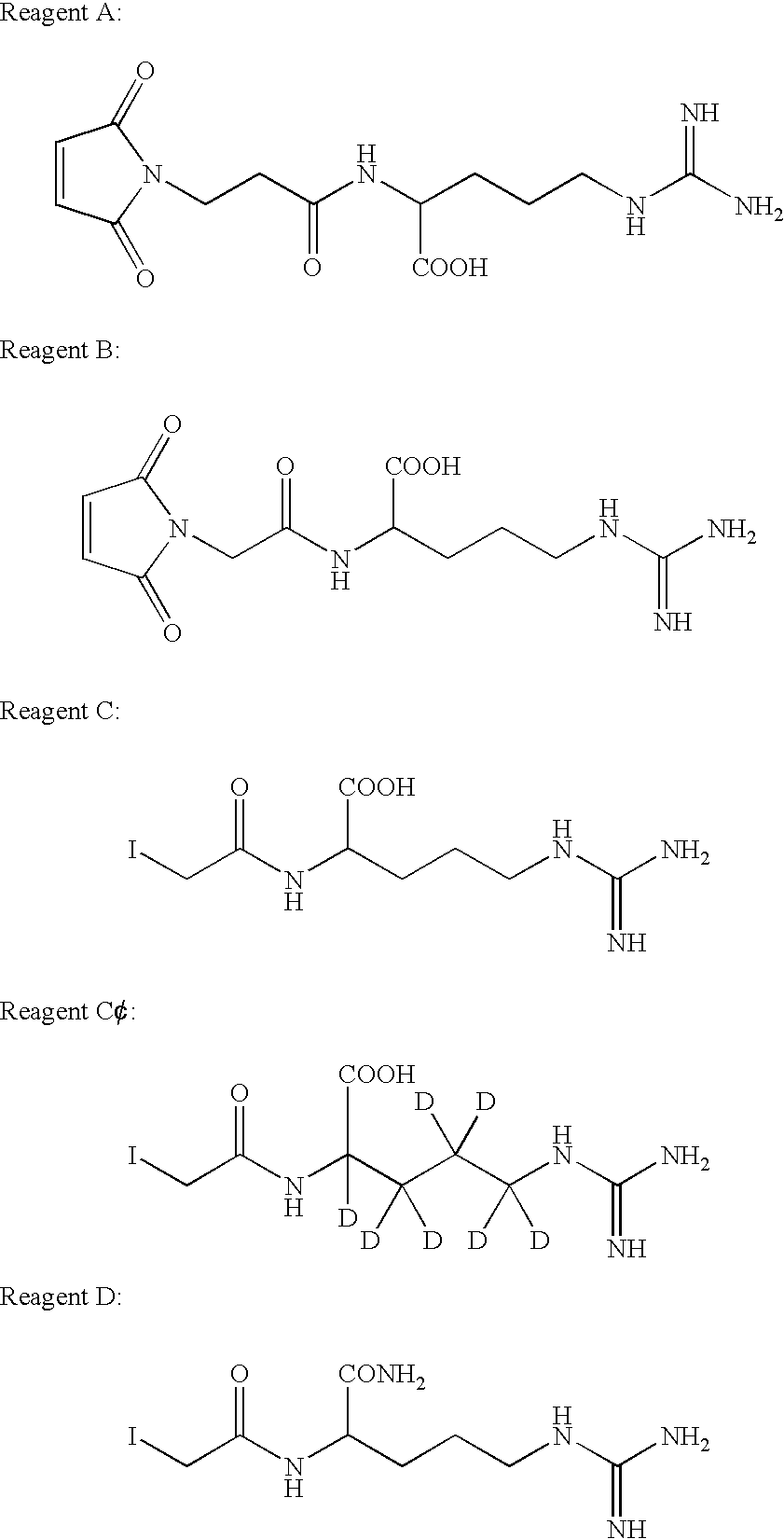Isotope-coded ionization-enhancing reagents (ICIER) for high-throughput protein identification and quantitation using matrix-assisted laser desorption ionization mass spectrometry
a ionization-enhancing and protein-based technology, applied in the field of high-throughput protein analysis, can solve the problems of low and low confidence level of peptide mass mapping, so as to improve the ionization efficiency of cysteine-containing peptides, reduce disulfide bonds of proteins, and improve the ionization efficiency of peptides
- Summary
- Abstract
- Description
- Claims
- Application Information
AI Technical Summary
Benefits of technology
Problems solved by technology
Method used
Image
Examples
example 1
Reagents of the Invention
[0040]This example illustrates methods for synthesis of exemplary compounds A, B, C, C′ and D of the invention. These compounds are useful as reagents in MALDI-MS and peptide mass mapping, as shown in the following examples.
[0041]1. 2-(2-(2,5-dioxo-2,5-dihydro-pyrrol-1-yl)-acetylamino)-5-guanidino-pentanoic Acid or Maleimidoacetyl Arginine (A):[0042](2,5-Dioxo-2,5-dihydro-pyrrol-1-yl)-acetic acid-2,5-dioxo-pyrrolidin-1-yl ester (4.8 g, 19 mmol) and L-arginine (2.9, 17 mmol) was stirred in 30 mL of a mixture of tetrahydrofuran (THF) and water, THF:H2O (1:1), for 16 hours at room temperature. The reaction mixture was poured into acetone (1.5 L) and the solid was collected. The solid was dissolved in H2O (3 mL) and then introduced onto Bakerbond (Octadecyl (C18) 40 μm prep LC Packing) column, and eluted with water to give 1.1 g of product. 1H NMR (D2O, 300 MHZ): 6.8 (s, 2H), 4.3 (Ha, d, J=16.9 Hz, 1H), 4.2 (Hb, d, J=16.9 Hz, 1H), 4.1 (dd, J=4.9, 7.7 Hz, 1H), 3....
example 2
Comparative Example Demonstrating Ionization Enhancement-MALDI-MS Analysis of Six Separate Model Proteins after Treatment with Either the Reagent of the Invention (Light Icier) or a Conventional Reagent (IAA)
[0051]A. Reduction:[0052]90 μg each of the six model proteins, CTLA-4-IgGl, Interleukin-12 (IL-12), α-Lactalbumin, Trypsinogen, Lysozyme, and Ribonuclease, were dissolved separately in 30 μL of the reaction buffer containing 5% SDS, 20% glycerol, and 750 mM Tris-HCl (pH 8.45) to obtain solutions of 3 μg / μL. To each solution was added a 200-fold excess (with regard to cysteine content per protein) of dithiothreitol (DTT). The reduction was allowed to proceed for 30 minutes at 90° C., followed by cooling of the solutions for 10 minutes.
[0053]B. Cysteine Modification:[0054]Reagent C (light ICIER) was synthesized as described in Example 1. Each of the six proteins was alkylated using both reagent C and iodoacetamide separately. The amount of the alkylating reagent (reagent C or iodo...
example 3
Protein Quantitation by Icier and MALDI-MS Using CTLA4-IgG as a Model Protein
[0082]Different amounts of CTLA4-IgG with ratios of 1:1, 1:1.5, 1:2, 1:5, and 1:10 were reduced by DTT as described in EXAMPLE 2. The samples to be compared were alkylated with either light or heavy ICIER and then mixed together before being subjected to gel electrophoresis, protein staining, in-gel digestion, and MALDI-MS analysis using the same conditions described in EXAMPLE 2.
[0083]Table XIX summarizes the labeling of CTLA4-IgG at different ratios using light and heavy ICIER. Peptide masses were all externally calibrated using default calibration files. The relative quantitation of the protein from two different pools was determined by averaging the mass intensity ratios between all seven pairs of peptides labeled by light and heavy ICIER.
[0084]
TABLE XIXTheor.Mass (Da)Peptide SequenceSEQ ID NO:Observed Ratios*1318.72(K)NQVSLTCLVK(G)11.231.642.29 4.22 8.91328.63(R)AMDTGLYICK(V)20.880.621.43 0.61 0.71374....
PUM
| Property | Measurement | Unit |
|---|---|---|
| molecular weight | aaaaa | aaaaa |
| molecular weight | aaaaa | aaaaa |
| temperature | aaaaa | aaaaa |
Abstract
Description
Claims
Application Information
 Login to View More
Login to View More - R&D
- Intellectual Property
- Life Sciences
- Materials
- Tech Scout
- Unparalleled Data Quality
- Higher Quality Content
- 60% Fewer Hallucinations
Browse by: Latest US Patents, China's latest patents, Technical Efficacy Thesaurus, Application Domain, Technology Topic, Popular Technical Reports.
© 2025 PatSnap. All rights reserved.Legal|Privacy policy|Modern Slavery Act Transparency Statement|Sitemap|About US| Contact US: help@patsnap.com



